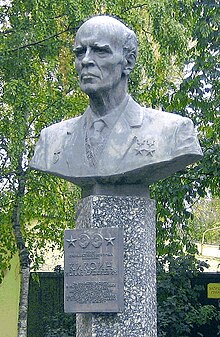Isaak Kikoin (original) (raw)
From Wikipedia, the free encyclopedia
Soviet physicist
| Isaak Kikoin | |
|---|---|
| Исаак Кикоин | |
 Bust of Isaak Kikoin in Pskov Bust of Isaak Kikoin in Pskov |
|
| Born | Isaak Kushelevich Kikoin(1908-03-28)March 28, 1908Malye Zhagory, Šiauliai County, Kovno Governorate, Russian EmpirePresent-day, Žagarė in Lithuania) |
| Died | December 28, 1984(1984-12-28) (aged 76)Moscow, Russia in Soviet Union |
| Resting place | Novodevichy Cemetery |
| Nationality | Lithuanian |
| Citizenship | USSR |
| Alma mater | Leningrad Polytechnic Institute |
| Known for | Soviet atomic bomb project |
| Awards | USSR State Prize Lenin Prize Hero of Socialist Labor |
| Scientific career | |
| Fields | Physics |
| Institutions | Laboratory No. 2Ural Polytechnic InstituteLeningrad Polytechnic Institute |
| Thesis | Photomagnetism (1936) |
Isaak Konstantinovich (Kushelevich) Kikoin (Russian: Исаак Константинович (Кушелевич) Кикоин; 28 March 1908 – 28 December 1984), D.N., was a Soviet physicist and an author of physics textbooks in Russian language who played an important role in the Soviet nuclear weapons program.: 27 [1]
Kikoin was born in the town of Novye Zhagory (now Žagarė in Lithuania), Russian Empire,[2] in a Lithuanian Jewish family; his parents, Kushel Isaakovich and Bunya Israilevna, were school teachers.[3][4] During the World War I, his family was relocated from Latvia to Russia where he entered in gymnazium in Pskov, and upon graduation, he went to study physics at the Leningrad Polytechnic Institute in 1925.[3]
In 1930-31, he earned his specialist degree in physics and successfully defended his thesis on Photomagnetism for his Doktor Nauk in 1936.[3] He taught physics at the Leningrad Polytechnic Institute, and his early work investigated the electrical conductivity and magnetic attractions in metals until 1938.[3] From 1938 till 1944, he taught physics at the Ural Polytechnic Institute and found a landmine project with the Red Army that would demagnetize, and detonate the German army's tanks.: 412 [5] It was Kurchatov who brought Kikoin in Soviet program of nuclear weapons and assigned him the Uranium enrichment project at this Laboratory No. 2 using the gaseous diffusion method took place under Kikoin while Lev Artsimovich worked on electromagnetic isotope separation.: 78 [6] During the Russian Alsos, he went to Germany to locate German knowledge that would prove useful in Soviet programs.: 24 [7]
He remained associate with Soviet program of nuclear weapons, and was an academician of the Academy of Sciences of the Soviet Union and was awarded the Stalin Prize a total of four times (1942, 1949, 1951, 1953), the Lenin Prize in 1959, and the USSR State Prize in 1967 and 1980. Kikoin was named a Hero of Socialist Labour (1951); he also won the Kurchatov Medal (1971).[8][9] Kikoin was with Igor Kurchatov as one of the founders of the Kurchatov Atomic Energy Institute, which developed the first Soviet nuclear reactor in 1946. This was the lead-in to the Soviet atomic bomb project with the first atomic bomb test taking place in 1949.
In 1970, Kikoin (jointly with Andrey Kolmogorov) started issuing Kvant magazine, a popular science magazine in physics and mathematics for school students and teachers.[9] He authored texts on molecular physics in 1978, and it has been translated in Persian language.[10]
- ^ Josephson, Paul (20 October 2022). Nuclear Russia: The Atom in Russian Politics and Culture. Bloomsbury Publishing. ISBN 978-1-350-27257-6. Retrieved 26 November 2022.
- ^ "БиблиоМ » КИКОИН Исаак Константинович (Кушеэлевич)". bibliom-ru.translate.goog. Retrieved 26 November 2022.
- ^ a b c d "Кикоин Исаак Константинович | jewmil.com". www.jewmil.com (in Russian). Retrieved 26 November 2022.
- ^ "Памятные даты Пскова". Archived from the original on 2019-02-14. Retrieved 2019-02-13.
- ^ Pondrom, Lee G. (25 July 2018). Soviet Atomic Project, The: How The Soviet Union Obtained The Atomic Bomb. World Scientific. ISBN 978-981-323-557-1. Retrieved 27 November 2022.
- ^ Riehl, Nikolaus; Seitz, Frederick (1996). Stalin's Captive: Nikolaus Riehl and the Soviet Race for the Bomb. Chemical Heritage Foundation. ISBN 978-0-8412-3310-2.
- ^ Hargittai, Istvan; Hargittai, Magdolna (20 August 2019). Science In Moscow: Memorials Of A Research Empire. World Scientific. ISBN 978-981-12-0346-6. Retrieved 27 November 2022.
- ^ Kikoin Isaac K. WarHeroes Biography. Accessed 2019-08-29.
- ^ a b Academician I.K. Kikoin: On the Centenary of His Birth. Herald of the Russian Academy of Sciences, 2008, Vol. 78, No. 1, pp. 91–98.
- ^ Física Molecular by Isaak Kikoin; Abram Kikoin: Good Hardcover (1971) 1st Edition. | Biblioteca de Babel. Retrieved 27 November 2022.